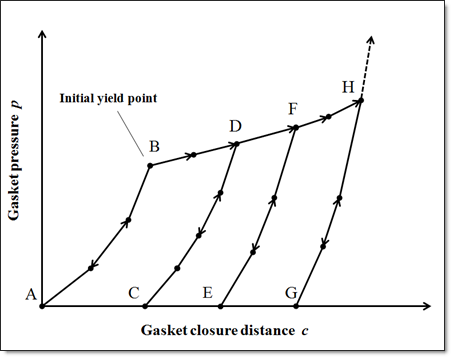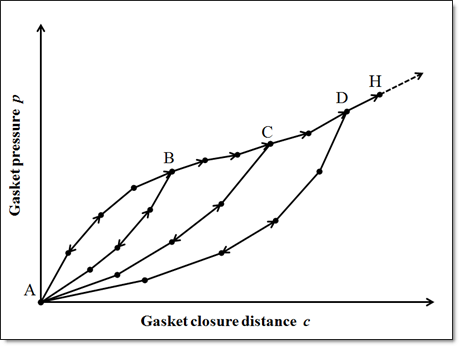MGASK |

|

|

|

|
|
MGASK |

|

|

|

|
Bulk Data Entry
MGASK – Gasket Material Property Definition
Description
Defining the material properties for gasket-like materials.
Format 1 (no temperature dependency)
(1) |
(2) |
(3) |
(4) |
(5) |
(6) |
(7) |
(8) |
(9) |
(10) |
MGASK |
MID |
BEHAV |
YPRS |
EPL |
GPL |
ALPHA |
EPLTYPE |
GPLUNIT |
|
|
TABLD |
TABLU1 |
TABLU2 |
TABLU3 |
TABLU4 |
TABLU5 |
TABLU6 |
TABLU7 |
|
|
TABLU8 |
|
|
|
|
|
|
|
|
Format 2 (temperature dependency defined)
(1) |
(2) |
(3) |
(4) |
(5) |
(6) |
(7) |
(8) |
(9) |
(10) |
MGASK |
MID |
BEHAV |
YPRS |
EPL |
GPL |
ALPHA |
EPLTYPE |
GPLUNIT |
|
|
TABLD |
TABLU1 |
TABLU2 |
TABLU3 |
TABLU4 |
TABLU5 |
TABLU6 |
TABLU7 |
|
|
TABLU8 |
TABLU9 |
-etc.- |
|
|
|
|
|
|
|
T |
TEMP1 |
|
|
|
|
|
|
|
|
PLUS |
|
YPRS |
EPL |
GPL |
ALPHA |
|
|
|
|
TABLD |
TABLU1 |
TABLU2 |
TABLU3 |
TABLU4 |
TABLU5 |
TABLU6 |
TABLU7 |
|
|
TABLU8 |
TABLU9 |
-etc.- |
|
|
|
|
|
|
|
T |
TEMP2 |
|
|
|
|
|
|
|
|
-etc.- |
|
|
|
|
|
|
|
|
|
|
Field |
Contents |
MID |
Material identification number. No default (Integer > 0) |
BEHAV |
Behavior type. See comment 12. Default = 0 (Integer (0 or 1 only)) 0 – elasto-plastic material |
YPRS |
Initial yield pressure for the thickness direction of the gasket material. Applies only to elasto-plastic behavior (BEHAV=0). If blank, it is determined automatically. For the groups of data starting with PLUS, default is the corresponding field value defined at the first line. |
EPL |
Tension stabilization coefficient or direct tensile modulus (based on the value of the EPLTYPE field) for the thickness direction of the gasket material. See comment 5. Default = 0.0 (Real > 0.0) For the groups of data starting with PLUS, default is the corresponding field value defined at the first line. |
GPL |
Transverse shear modulus of the gasket material (the unit of measure depends on the value of the GPLUNIT field). Default = 0.0 (Real > 0.0) For the groups of data starting with PLUS, default is the corresponding field value defined at the first line. |
ALPHA |
Coefficient of thermal expansion in the normal direction. Default = 0.0 (Real > 0.0) For the groups of data starting with PLUS, default is the corresponding field value defined at the first line. |
EPLTYPE |
Type of definition of EPL. See comment 12. Default = 0 (Integer (0 or 1 only)) 0 – EPL is defined as a tension stabilization coefficient |
GPLUNIT |
Type of the unit of measure of GPL. See comment 12. Default = 0 (Integer (0 or 1 only)) 0 – stress per unit displacement |
TABLD |
Identifier of a TABLES1 table providing loading path of the gasket material (pressure vs. closure). No default (Integer > 0) |
TABLUi |
Identifier of TABLES1 table providing unloading/reloading path of the gasket material (pressure vs. closure). If there is no unloading, leave the fields blank. Default = blank (Integer > 0 or blank) |
T |
Temperature flag indicating that a temperature value will be defined in the next field. |
TEMPj |
Temperature for the group of data above. See comment 11. No default (Real) |
PLUS |
Keyword indicating that the following is a group of data defined at another temperature. See comment 12. |
| 1. | The material identification number must be unique for all MAT1, MAT2, MAT3, MAT8, MAT9 and MGASK entries. |
| 2. | MGASK mainly defines nonlinear properties in the thickness direction for gasket-like materials under compression. MGASK has anisotropy only in the thickness direction, which is called normal anisotropy. For linear analysis, the thickness-direction modulus (stress per unit displacement) is defined by the slope of the first segment of the loading pressure-closure curve TABLD. |
| 3. | MGASK also defines the transverse shear and thickness-direction tension behaviors with linear properties. (The membrane properties of the gasket are defined by a MAT1, referenced from the PGASK property.) |
| 4. | The thickness direction of gasket material is the principal direction (local 3-direction) in 3D solids. Gasket closure is defined as the relative change in position of the top and bottom surfaces of the gasket element along the gasket thickness direction. |
| 5. | If EPL is defined as a tension stabilization coefficient (EPLTYPE = 0), the tensile modulus will be calculated as the initial slope of the first segment of the loading curve TABLD multiplied by EPL. If EPL is defined as a direct tensile modulus (EPLTYPE = 1), its unit of measure is stress per unit displacement. If EPL is zero, a small tensile modulus will be used automatically for stabilization (no matter EPLTYPE is 0 or 1). |
| 6. | All the data points in tables TABLD and TABLUi are specified in the first quadrant. Points on loading (TABLD) and unloading/reloading (TABLUi) paths must be defined in order of increasing pressure and distance. |
| 7. | For elasto-plastic material (BEHAV = 0), |
| • | The initial yield pressure should match a point in table TABLD. If the initial yield pressure is not specified, it will be determined automatically by finding the first point on the TABLD curve where the slope changes by more than 10%. |
| • | The loading path starts from the origin to initial yield pressure (nonlinear elastic range) and continues with strain hardening slope into the plastic region. |
| • | All unloading/reloading paths must start with zero pressure and positive closure distance, and end at the loading path in the plastic region. Subsequent unloading/reloading curves must start with larger closure distances (when pressure is zero) and end with larger closure distances than previous unloading/reloading curves. |
| 8. | For elastic material with damage (BEHAV = 1), |
| • | All loading and unloading/reloading curves must start at the origin of the coordinate system (0, 0). |
| • | All unloading/reloading paths must end at the loading path. Subsequent unloading/reloading curves must end with larger closure distances than previous unloading/reloading curves. |
| 9. | Unloading/reloading behavior at undefined paths will be interpolated between two adjacent unloading/reloading paths. |
| 10. | For closures larger than the last user-specified closure, the pressure-closure relationship is calculated as follows: |
| • | For elasto-plastic material (BEHAV = 0), it follows the last segment of the furthest unloading/reloading curve. This behavior is fully elastic and represents crushed gasket. |
| • | For elastic material with damage (BEHAV = 1), it follows last slope computed from the user-specified data. |

Elasto-plastic gasket material

Elastic gasket material with damage
| 11. | If temperature dependency is defined, TEMPj should be provided in ascending order and the loading path (and unloading/reloading paths, if required) should be provided for each temperature. If temperature dependency is defined but the temperature field for material property is not provided, the first group of data will be used to calculate the material property. TEMPj are defined for all MGASK data fields (data groups) that lie between the respective TEMPj and its previous PLUS field. TEMP1 is an exception to this rule as it is defined for all data fields that lie between itself and MID. |
|
12. BEHAV, EPLTYPE and GPLUNIT fields after any PLUS field should remain blank because their values are always the same as those of the first-group data.
See Also: